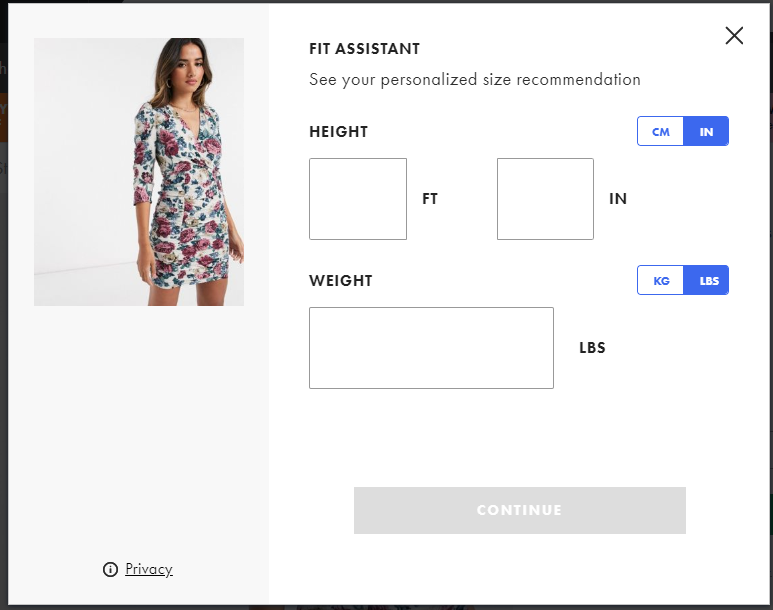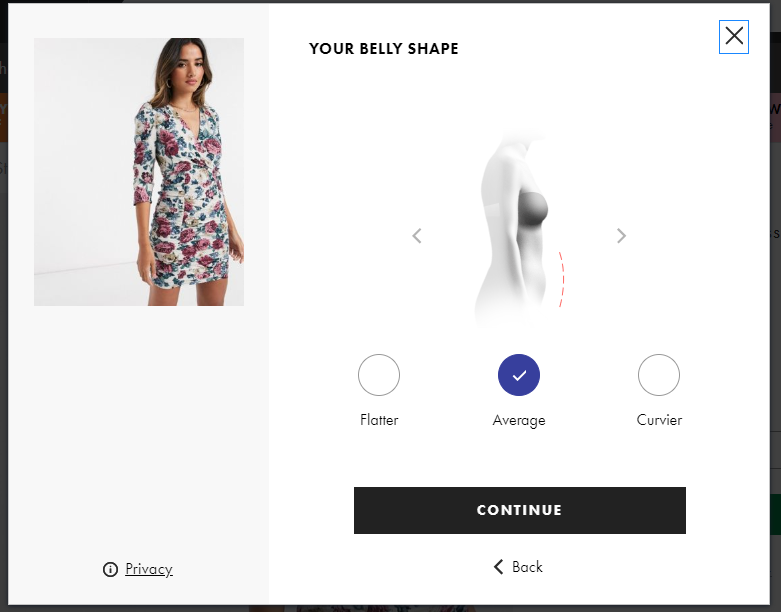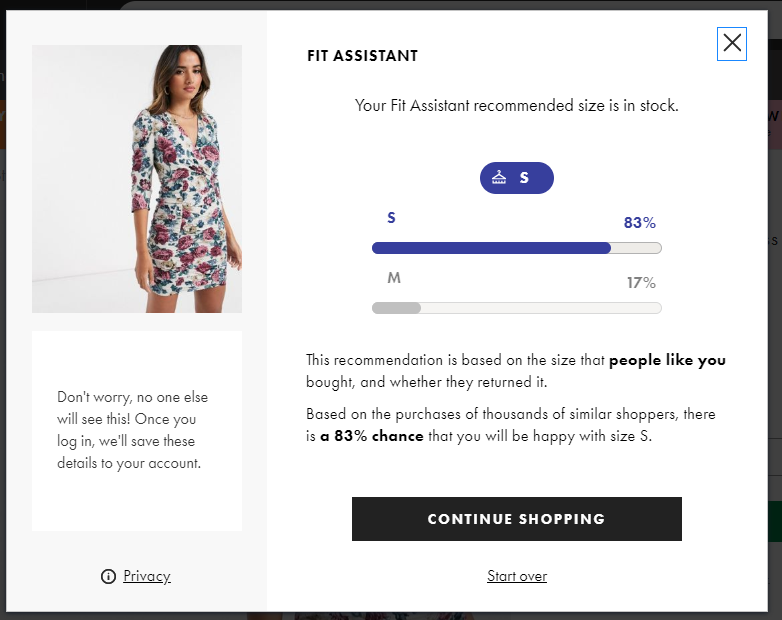I recently bought a pair of pants. This should be unremarkable, but pants shopping is such an absolute nightmare for most women that it is, for many of us, a significant life event. It’s an investment of money and often requires a significant investment of time, emotional energy, and space in the group chat in which the relentless relitigation of the value of a particular pair becomes the main topic of conversation for… too long.
Anyway, I bought these pants on Madewell’s website, which has a quiz you can take to determine your size in that particular item. The size it recommended was one size down from the size I wear in another brand, Everlane, so I didn’t believe it. No way did I fit into that size. I ordered my usual, which, when they arrived, were — you guessed it — way too big.
Quizzes like the one I took that correctly insisted I size down are a well-intended solution to fixing this problem, which can be annoying, expensive, and even environmentally unsound, thanks to the emissions from shipping and the impact of making the clothes to begin with. Though it may seem like a minor innovation to some — perhaps especially to those who don’t mind a loose-fitting cargo pant — the quiz software could represent a legitimate solution to all these problems, making online shopping in the future a much more viable option and reshaping how we spend our cash.
Kristine Englert, director of enterprise marketing at True Fit, one of the biggest sizing-quiz software companies, with clients including Kate Spade, Lane Bryant, and Levi’s, says the company’s research has found that a particular size can correspond to dramatically different fits, depending on the brand. “A size six in women’s jeans, for instance… could really be anywhere from a two [to a] 10 based on the brand,” she says. “Wild, right?”
Truly. Academic studies support True Fit’s findings. One of the most thorough, a 2003 study out of the University of North Texas, analyzed 1,011 pairs of women’s pants across a variety of brands and found that sizes varied in every measurement category. While the mean waist measurement for a size four pair of pants was 27.97 inches, the overall range spanned from 23 to 31.5 inches. The study notes that brands have different sizing standards to accommodate who they perceive to be their target customer — for example, a brand with a teenage customer base may size its products smaller in the bust — which places the onus on consumers to figure out which brands fit them and in what size.
A more recent study, from 2017, found similar results. Across women’s clothing categories, “moderately expensive” brands (like L.L.Bean and Abercrombie & Fitch) had larger measurements than discount brands (Forever 21, Old Navy), but ultra-expensive designer brands (Burberry, Kate Spade) measured significantly smaller. These differences were not found in men’s or children’s clothing.
“We collected hundreds of thousands of images [of customers], and that’s really still the basis of our technology.”
These small differences can have a big impact. Shipping returns release an average of 15 million metric tons of carbon dioxide emissions in the United States alone each year, according to returns optimization platform Optoro. (Though because this is industry-funded data, it’s worth taking it with a pinch of salt.) Only about 50% of inventory ends up back on the (digital) shelf, according to Optoro. That means 5 billion pounds of returned stuff ends up in U.S. landfills annually. Plus, shipping things is a pain in the butt and occasionally costly for the consumer.
You might say, “Just shop in person!” It’s a decent piece of advice if you fit the profile of someone who can do so: able-bodied, living in a mid- to large-sized city with shopping options, and what the fashion industry considers a “desirable” size, at least according to what brands carry on the shelves. I, for example, cannot walk into a store and assume anything is going to fit, especially if I’m shopping for pants: I’m five feet tall with a 26-inch inseam. If I want a pair of pants, I have to order online. If you’re plus-size, even brands that make your size might not carry it in physical stores, leaving the guesswork of an online shopping experience your only option.
That’s where fit quizzes come in.
“I do all my ASOS shopping using their fit recommendations now,” says Alice Beverton-Palmer, a social media partnerships manager based in London. “The other week, I did a big order of gym wear — quite tight, so you need the right fit! — and didn’t bother ordering two sizes of anything. It all fit.”
Shoppers on ASOS can take a quiz that advises them on their approximate size in a particular style. First, it asks for your height and weight:

Then it asks you to describe your general body proportions, like belly shape, hip shape, and bra size.

Finally, it asks you what size you are in other brands. The more data you give it, the more accurate it will be.

ASOS uses a software company called Fit Analytics to run its size quiz and recommendations algorithm. The company launched in 2010, when it required customers to submit photos of themselves wearing black and holding CDs for size reference. Initially, it ran into adoption issues, says Jason Wolf, head of sales at Fit Analytics. “But it worked — it was very effective,” he says. “We collected hundreds of thousands of images, and that’s really still the basis of our technology. But then we realized in order for people to widely adapt the solution, we needed an easier approach and shifted over to the survey-based approach.”
Fit Analytics now runs the quiz software for 17,000 brands, including The North Face, Mango, and Alexander McQueen. It compares the consumer survey data to information provided by the retailer, including size charts, product measurements, and purchase and return data, to determine what size will best fit the shopper taking the quiz.
Of course, it doesn’t always work. When I took the quiz for a North Face fleece, it advised me to purchase a size small — despite the fact that I own the same product in a child’s size medium, which is roughly the same dimensions as an adult women’s extra small. I was baffled that it would tell me to size up — was I inputting the incorrect weight measurement? (I don’t own a scale, so my guess could be off.) Do other shoppers prefer the item to be baggy, to allow for better layering? It wasn’t clear. Taking a look at the reviews, it appeared that similarly proportioned shoppers prefer the size I currently own, making the results of the quiz even more confusing.
Dan Mayer, head of product at Fit Analytics, says my sizing recommendation is based on what other people have bought and kept. “Even if extra small is the closest equivalent, there are still subjective variations (distribution of weight, fit preference, etc.) that would cause some people to buy and keep small instead of extra small. That means for shoppers with your same answers as of today, 67% of those women did buy a size small and kept it; however, one-third of the shoppers chose to buy an extra small and ended up keeping it,” he says. “If you were to buy the small and return it for an extra small, that returns information would then be used to improve the algorithm for future recommendations.”
According to Rebecca Wang, an assistant professor of marketing at Lehigh University, fit technology is in its infancy, so it’s encountering some speed bumps that make enthusiastic adoption difficult. “It’s almost a double-edged sword. On the one hand, it gives consumers confidence when they shop and choose online. On the other hand, when the fit turns out to be incorrect, consumers might feel disappointed,” she says. “This said, tools that help consumers make the right choices during their shopping journey are going to continue to improve and be implemented.”
The more people use fit quiz software, the better the recommendations will be. And to do that, companies like Fit Analytics and True Fit need to improve their user experience. Right now, both have confusing interfaces that are difficult to access on retailer’s websites — quizzes are buried on product pages instead of prominently displayed on retailer homepages, for example. Furthermore, sizing recommendations need to more clearly communicate why shoppers need a particular size in a specific product.
Shira Abel, a tech CEO based in San Francisco, says that because she’s 5’2″, finding pants is “a mess.” The sizing quizzes don’t work for her, however, because the brands their algorithms compare are limited to a few big companies. I ran into this issue, too; the ASOS quiz wouldn’t allow me to input several of the main brands I most commonly wear, like Everlane and Madewell (I realize I am a cliché!), which might explain why it struggled to recommend the best sizes for me.
But as these algorithms continue to improve, more people will use them (hopefully), making online shopping much more pleasant than its current state of what I would call a “hell pit.” Tracy Robey, a skin care blogger and cultural historian who has written about the history of sizing variations across brands, says she thinks fit quizzes are “magical.” “It’s great for folks who don’t have brick-and-mortar options nearby,” she says. “My only concern is that the crappy predictions are going to put people off these widgets forever, even if they improve.”
Shoppers are slowly but surely starting to use these fit quizzes. Fit Analytics told me the company is seeing a 30% adoption rate and a 3% to 5% reduced rate of product returns, which is a good start. But as shopping continues to move online, it’s increasingly important that brands find ways to ease the experience, for the sake of the shopper’s mood (and loyalty) and to prevent unnecessary—and costly—returns.
onezero.medium.com

Putting a spotlight on business, inventions, leadership, influencers, women, technology, and lifestyle. We inspire, educate, celebrate success and reward resilience.















